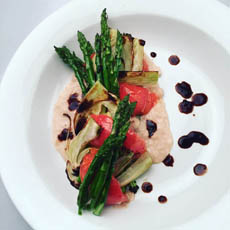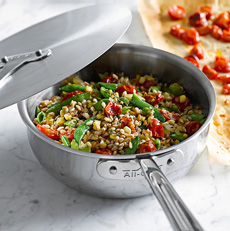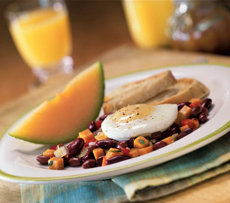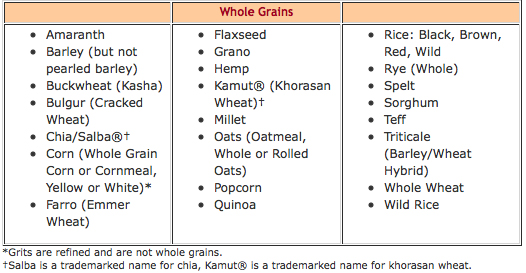TIP OF THE DAY: Delicious Ways To Eat More Grains & Legumes

|
Head to any fine-casual dining spot and the menu is sure to include quinoa, other whole grains (barley, buckwheat, bulgur, farrow) and often, bean and lentil dishes.
While consumers increasingly respond to these healthful alternatives when dining out, many of us still aren’t in the groove of serving them at home. Some people do their best to put nutritious meals on the table, while others have to default to convenience. But with some easy planning, you can have both deliciousness and healthfulness: Just about every grain and legume can be prepared in an hour or two on the weekend, and heated up as needed. Grains and legumes have also been turned into convenience. You can buy them frozen or in boil bags, and boil or microwave them. As with the frozen vegetables, enjoy the same nutrition. And all of us should now know how to season better with herbs and spices, instead of the salt and pepper shakers of yore. Since the dawn of personal wealth, meat has been a sign of prosperity. Diets of mostly grains, beans and vegetables were fare for the less prosperous. Whereas in other cultures meat—especially beef—remains a luxury, the U.S. has always had enough grazing land to produce large quantities of it. Quantity drove down prices, and a result, people ate more meat. In fact, many families could eat it at every meal, starting with breakfast meats. As a result, the grains and legumes that still comprise a major part of other cuisines were passed over in favor of meat-and-starch diet: bacon or sausage at breakfast, a ham or roast beef sandwich for lunch, beef, chicken or pork for dinner. Our eating habits grew out of balance. Case in point: Spaghetti and [large] meatballs that are a signature “Italian” dish are actually Italian-American. It doesn’t exist in classic Italian cuisine. Few people in the old country could afford large amounts of meat on a regular basis—but working-class immigrants to the U.S. could. Americans eat too much processed food (and too much meat) and not nearly enough whole food. This is one reason why we have growing rates of stroke, type 2 diabetes, heart disease, certain cancers, obesity, and gastrointestinal disorders like constipation. While selling the general public on whole grains and legumes as “healthful” isn’t the best marketing approach for many consumers, “delicious” usually works. And truth to tell, it is easy to make these foods taste delicious. There’s an easy solution below. But first… |
|
|
WHAT ARE WHOLE GRAINS? Whole grain are cereals with that have their germ, endosperm and bran intact, in contrast to refined grains which retain only the endosperm, and thus tend to retain little nutritional value after being processed. There’s overwhelming evidence that a diet including a sufficient quantity of whole grains can result in a healthier, and therefore better, life. The USDA recommends 48 grams of whole grains per day. It doesn’t matter if the grains are cooked ass is or ground into flour: Corn on the cob is a whole grain food, as are cornbread and polenta, made from cornmeal (corn flour). The choice boils down to this: Eat refined white flour and white rice, or switch to better-for-you whole grains from the chart below. You can snack on potato chips, or switch to whole grain snacks like popcorn and whole-grain pretzels. (Note: “multigrain” is not “whole grain”: It can indicate a combination of two or more refined grains.) Here’s more about whole grains.
|
||
|
WHAT ARE LEGUMES? Legumes are plants that contain their fruits in pods. They are generally low in fat, high in protein and full of fiber and other nutrients (calcium, folic acid, iron, magnesium, zinc, etc.). Examples include all forms of dried seeds, beans and peas, such as chickpeas, navy beans, soybeans, black beans, lentils, and black-eyed peas. Among other things, legumes can help prevent blood sugar spikes. They help to lower cholesterol and contribute to gastrointestinal well-being. The USDA recommends that individuals consume three servings of whole grains each day—about half of your total grain intake—and about half a cup of legumes daily. They can be easily substituted for pasta, white rice and potatoes. 14 WAYS TO EAT MORE WHOLE GRAINS & LEGUMES, AND LOVE THEM! In our youth, one of the women’s magazines our mother bought had a meal calendar for the month: literally, a monthly calendar page with a suggested dinner menu for every day. The meals were very varied—beyond the meat and potatoes that were popular at the time—and the dishes easy to make. As kids, we delighted in selecting which Birdseye frozen vegetables would be served at dinner. But the point is the planning. If you take one of the wall calendars you picked up at the bank, you can write in a whole grain and/or legume for every day of the month. Then, implementing is easy. Here are just a few ideas that can be incorporated into your everyday meals: |

|
|
|
|
||







